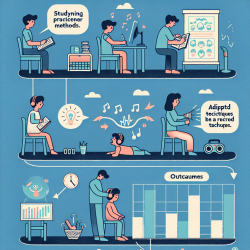Introduction
Depression is a significant cause of disability among children and adolescents, affecting their academic performance, social interactions, and overall well-being. As practitioners, staying informed about the latest research and evidence-based practices is crucial to improving mental health outcomes for young individuals. The systematic review titled "Depression screening and mental health outcomes in children and adolescents: a systematic review protocol" by Thombs et al. (2012) offers valuable insights into the effectiveness of depression screening tools and interventions. This blog aims to help practitioners enhance their skills by implementing the research outcomes or encouraging further exploration in this critical area.
Understanding the Research
The systematic review by Thombs et al. (2012) evaluates the accuracy of depression screening tools, the efficacy of depression treatments, and the potential harms associated with screening and interventions. The research highlights the importance of accurate screening tools to detect major depressive disorder (MDD) in children and adolescents, as well as the effectiveness of treatment interventions. The study also explores whether depression screening improves outcomes compared to usual care and identifies potential harms related to screening and treatment.
Key Findings
- Accuracy of Screening Tools: The research emphasizes the need for precise screening instruments to accurately identify cases of MDD among children and adolescents. Accurate screening is crucial to avoid false positives and negatives, which can lead to inappropriate treatment or missed diagnoses.
- Efficacy of Treatment: The study reviews randomized controlled trials (RCTs) of pharmacological and psychotherapeutic treatments, concluding that treatments are generally effective in improving depressive symptoms. However, not all medications work equally well, highlighting the importance of tailored interventions.
- Impact of Screening on Outcomes: The research investigates whether depression screening improves mental health outcomes compared to usual care. While the evidence is still emerging, the study suggests that screening can be beneficial when integrated with comprehensive depression management services.
- Potential Harms: The review identifies potential harms associated with depression screening and treatment, such as inappropriate labeling, stigma, and adverse effects from treatment. Practitioners must weigh these risks against the benefits when considering screening programs.
Implications for Practitioners
Practitioners can enhance their skills by incorporating the findings of this systematic review into their practice. Here are some actionable steps:
- Stay Informed: Regularly update your knowledge on depression screening tools and treatment options by attending conferences, reading publications, and participating in webinars.
- Implement Evidence-Based Screening: Use validated screening tools with proven accuracy to identify MDD in children and adolescents. Ensure that screening is part of a broader mental health management strategy.
- Tailor Treatment Approaches: Consider the individual needs of each child or adolescent when recommending treatment options. Collaborate with mental health professionals to provide comprehensive care.
- Evaluate Potential Harms: Be mindful of the potential harms associated with screening and treatment. Engage in open communication with patients and their families to address concerns and minimize risks.
Encouraging Further Research
The systematic review by Thombs et al. (2012) underscores the need for ongoing research to refine depression screening and treatment practices. Practitioners are encouraged to contribute to this body of knowledge by participating in research studies, sharing clinical experiences, and advocating for evidence-based practices in their communities.
To read the original research paper, please follow this link: Depression screening and mental health outcomes in children and adolescents: a systematic review protocol.










